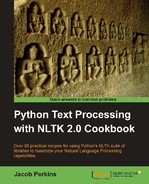Book Description
Use Python's NLTK suite of libraries to maximize your Natural Language Processing capabilities.
Quickly get to grips with Natural Language Processing - with Text Analysis, Text Mining, and beyond
Learn how machines and crawlers interpret and process natural languages
Easily work with huge amounts of data and learn how to handle distributed processing
Part of Packt's Cookbook series: Each recipe is a carefully organized sequence of instructions to complete the task as efficiently as possible
In Detail
Natural Language Processing is used everywhere - in search engines, spell checkers, mobile phones, computer games - even your washing machine. Python's Natural Language Toolkit (NTLK) suite of libraries has rapidly emerged as one of the most efficient tools for Natural Language Processing. You want to employ nothing less than the best techniques in Natural Language Processing - and this book is your answer.
Python Text Processing with NTLK 2.0 Cookbook is your handy and illustrative guide, which will walk you through all the Natural Language Processing techniques in a step–by-step manner. It will demystify the advanced features of text analysis and text mining using the comprehensive NTLK suite.
This book cuts short the preamble and you dive right into the science of text processing with a practical hands-on approach.
Get started off with learning tokenization of text. Get an overview of WordNet and how to use it. Learn the basics as well as advanced features of Stemming and Lemmatization. Discover various ways to replace words with simpler and more common (read: more searched) variants. Create your own corpora and learn to create custom corpus readers for JSON files as well as for data stored in MongoDB. Use and manipulate POS taggers. Transform and normalize parsed chunks to produce a canonical form without changing their meaning. Dig into feature extraction and text classification. Learn how to easily handle huge amounts of data without any loss in efficiency or speed.
This book will teach you all that and beyond, in a hands-on learn-by-doing manner. Make yourself an expert in using the NTLK for Natural Language Processing with this handy companion.
Table of Contents
- Python Text Processing with NLTK 2.0 Cookbook
- Table of Contents
- Python Text Processing with NLTK 2.0 Cookbook
- Credits
- About the Author
- About the Reviewers
- Preface
- 1. Tokenizing Text and WordNet Basics
- Introduction
- Tokenizing text into sentences
- Tokenizing sentences into words
- Tokenizing sentences using regular expressions
- Filtering stopwords in a tokenized sentence
- Looking up synsets for a word in WordNet
- Looking up lemmas and synonyms in WordNet
- Calculating WordNet synset similarity
- Discovering word collocations
- 2. Replacing and Correcting Words
- 3. Creating Custom Corpora
- Introduction
- Setting up a custom corpus
- Creating a word list corpus
- Creating a part-of-speech tagged word corpus
- Creating a chunked phrase corpus
- Creating a categorized text corpus
- Creating a categorized chunk corpus reader
- Lazy corpus loading
- Creating a custom corpus view
- Creating a MongoDB backed corpus reader
- Corpus editing with file locking
- 4. Part-of-Speech Tagging
- Introduction
- Default tagging
- Training a unigram part-of-speech tagger
- Combining taggers with backoff tagging
- Training and combining Ngram taggers
- Creating a model of likely word tags
- Tagging with regular expressions
- Affix tagging
- Training a Brill tagger
- Training the TnT tagger
- Using WordNet for tagging
- Tagging proper names
- Classifier based tagging
- 5. Extracting Chunks
- Introduction
- Chunking and chinking with regular expressions
- Merging and splitting chunks with regular expressions
- Expanding and removing chunks with regular expressions
- Partial parsing with regular expressions
- Training a tagger-based chunker
- Classification-based chunking
- Extracting named entities
- Extracting proper noun chunks
- Extracting location chunks
- Training a named entity chunker
- 6. Transforming Chunks and Trees
- 7. Text Classification
- Introduction
- Bag of Words feature extraction
- Training a naive Bayes classifier
- Training a decision tree classifier
- Training a maximum entropy classifier
- Measuring precision and recall of a classifier
- Calculating high information words
- Combining classifiers with voting
- Classifying with multiple binary classifiers
- 8. Distributed Processing and Handling Large Datasets
- Introduction
- Distributed tagging with execnet
- Distributed chunking with execnet
- Parallel list processing with execnet
- Storing a frequency distribution in Redis
- Storing a conditional frequency distribution in Redis
- Storing an ordered dictionary in Redis
- Distributed word scoring with Redis and execnet
- 9. Parsing Specific Data
- A. Penn Treebank Part-of-Speech Tags
- Index
